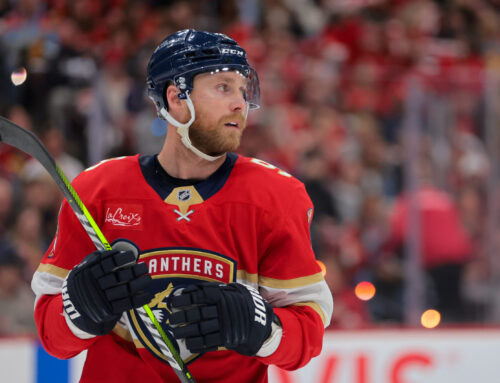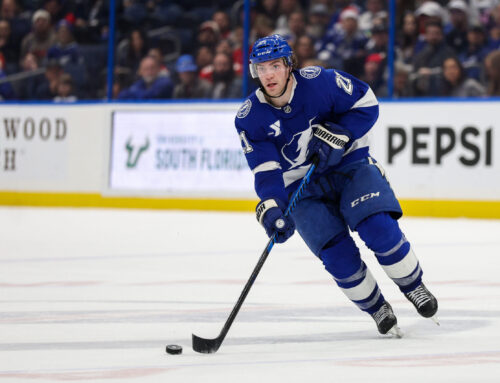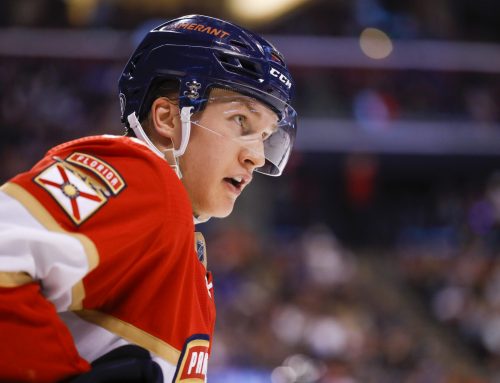Welcome back to your monthly installment of Goldipucks and the Three Skaters, which, for new readers, is a play on words of the Goldilocks and the Three Bears story. Here though, instead of there being three bowls of porridge I cover three skaters and declare one too hot (i.e., doing unsustainably better than he should), another too cold (i.e., doing unsustainably worse), and a third “just right” (i.e., producing where he should be). I also assign each a rating of 1-10, indicating just how hot (rated 7-10, where 10 is the most unsustainably hot), or how cold (rated 1-4, where 1 is the most unsustainably cold), or how “just right” (rated 4-7, where 5.5 is the most “just right”) he is.
Like last month we have all Western Conference skaters on tap in David Perron, Bo Horvat, and Jonathan Marchessault. For added enjoyment, think of which one you believe is too hot, too cold, and just right, then read on to see if you were correct when making your guesses.
The former first round pick had a 50-point season at age 21 and seemed on the fast track to becoming an impact player. But it was downhill from there, as injuries and inconsistency led to him being gone from St. Louis within five seasons. Things looked up again after a 57-point 2014-15 season with Edmonton; but he fell even farther from grace after that, as him being selected by Vegas in the 2017 expansion draft marked the fifth time he changed teams in three seasons! But playing top minutes for the Knights, Perron shined; counting this season, he's had 172 points in his last 198 games, for a point per game scoring rate higher than the likes of Kyle Connor, Matthew Tkachuk, and even teammate Vladimir Tarasenko. So it's safe to assume this resurgence will continue, right? Not so fast…..
Although Perron scored at a 66-point pace in 2018-19 and a 69-point pace this season, both look to be inflated. This season, for example, he had 27 PPPts after a previous high of 18 and an average in his two previous seasons of 16. Moreover, those 27 PPPts tied him for seventh among all forwards despite him receiving only the 38th most PP minutes. Of the others who scored as many or more PPPts as him, all averaged at least 30 seconds more of PP time per game, with more than half receiving at least 45 more seconds. So right there he likely lucked into at least a half dozen points he shouldn't have received.
Perron also received a full minute more of ice time in 2019-20 than in either of his two prior successful seasons, likely due to the extended absence of Vladimir Tarasenko. Upon the return of Tarasenko, chances are Perron's ice time drops to the 17:00 to 17:30 he normally receives, if even that, as St. Louis has young players like Robert Thomas, Sammy Blais and Jordan Kyrou all angling for more minutes, which could come at Perron's expense. And a lot of that lost time figures to be on the PP, where never in his entire career had he taken the ice for more than 50.7 percent of his team's PP minutes, but he did so for 65.3 percent this season. In fact, even with him producing on the PP and no Tarasenko, as a possible sign of things to come Perron's PP Minutes per game were dropping each quarter and his ice time as a whole was down to 17:16 by Q4, when he posted a mere three points in eight games.
Okay, so maybe that explains his luck for 2019-20; but what about 2018-19, when there was a healthy Tarasenko in the mix? It just so happens, that season Perron had an IPP (defined as the percentage of goals scored – with Perron on the ice – where Perron received a point) of 79.3 percent, when only one other time – including this season and dating way back to the 2013-14 campaign – saw him with an IPP of even 68 percent.
Seeing Perron finally live up to expectations now in his 30s has been a nice story. However, those who own him in leagues should prepare for Perron to shed points in 2020-21, what with a healthy Tarasenko back in the mix and young players angling to step up. Although I don't see the Blues pushing Perron aside entirely, he figures to be deemphasized, leading to a drop in production even factoring in a high scoring team around him. Figure Perron for 55-60 points next season, with a better chance of falling below 55 than above 65. As such, for 2019-20 Perron was TOO HOT and gets an 8.5 rating. If you own him in a keeper league, I'd look to move him before next season rolls around.
Amazingly, Horvat has seen his scoring pace increase with each passing season of his career. But in the past few years the gains have slowed; so should we figure he's likely reached his peak of 60-65 points, in which range his scoring pace was for 2018-19 and 2019-20? On the contrary – I'd look for him to take a larger stride in production in 2020-21, with a 70+-point pace more likely than not.
As was the case with Perron, Horvat saw time on virtually two-thirds of his team's man advantage minutes. But unlike Perron, that wasn't an aberration, in that the same was true for 2018-19. Where he also differs from Perron is he was unlucky on the PP, receiving the 11th most PP minutes among all NHL forwards yet finishing tied for 57th in PP scoring. And all but two of those who received more PP minutes scored at least a six more PPPts, with half having at least ten more.
But could it be that Horvat is just not a PP scorer, as in 2018-19 he received the 17th most PP minutes and only tied for 54th in PPPts? While that does show perhaps Horvat is not a PP monster, there's the reality that in 2019-20 Vancouver had 57 PPGs in 69 games, for an 82 game pace of 68, versus 43 PPGs in all 82 games last season. That's a major differential; and even if Horvat isn't a PPPt magnet, he still should've benefitted more than he did.
In terms of other factors, the arrival of J.T. Miller cemented Horvat as the team's second line center; but rather than that hurting Horvat's output, it helped, as defenses keyed on the top line, allowing Horvat's trio to avoid tougher defensive match-ups. Horvat also formed great chemistry with the resurgent Tanner Pearson, who is set to be a UFA after the 2020-21 season, making it all the more likely his stellar play continues. And with the further maturation of Jake Virtanen, to likely take the place of the aging and lackluster Loui Eriksson on that line, higher scoring presumably lies ahead for Horvat.
Moreover, much in the way that Horvat should see organic gains in PP scoring due to the team around him getting better, his overall production should likewise benefit. Horvat is not a points magnet, having sported an IPP in the range of 58.7 to 61.0 percent over the past three seasons. But that's not a bad thing if the team around him improves, which most definitely is the case. After all, Vancouver had 224 goals this season – in 69 games, for a 266-goal full season pace – versus 218 and 219 in the previous seasons. What's more, the Canucks averaged 3.47 goals per game in their last 34 contests, which translates to a full season scoring rate of 284 goals. And as I've said in my columns previously, a rising tide lifts all boats, and that would include Horvat, as a top six and PP1 fixture.
All things considered, Horvat should continue his pattern of improved scoring with each passing season, but for 2020-21 he'll be in line for a larger than usual jump in production, due to the better team around him, a set in stone spot on a potent PP1, and linemates who should perform well and not be forced to play against the best defenses of their opponents. When the dust settles, I'd bank on Horvat finishing with 70+ points, which probably will be close to his ceiling due to him not having the team's best talent surrounding him and a low offensive zone starting percentage. Accordingly, Horvat's 2019-20 was TOO COLD and his rating was a 3.0.
In three of his last four seasons, including one with Florida, Marchessault has scored at pace of 56-59 points. So, easy-peasy, that's what we should expect from him in 2020-21? Maybe not, as in 2017-18 his scoring pace was 75 points. So could Marchessault either rise back to that level again, or at least closer to it? Probably not, as more and more evidence suggests he is what he seems, which is a 55-60 point player.
First, we need to look for signs that 2017-18 was like or unlike other seasons and, in turn, whether we should expect him to be able to score at that level again. His ice time was 17:30, which was not his highest among these four seasons, nor was his PP Time per game average of 2:28. If we assess all four of his most recent seasons together, the 17:30 from 2017-18 is barely above his average ice time of 17:24 per game from all four seasons, and his PP Time of 2:28 from 2017-18 is comparable to his 2:30 PP Time per game average from all four seasons. On top of that, although his SOG rate for 2016-17 was low enough not to analyze, his rates for the past three seasons have been 3.56 (2019-20), 3.39, (2018-19), and 3.48 (2017-18); thus yet again his average in his best season is on a par with his average over three seasons. So right there is evidence that his 2017-18 production is suspect.
Digging deeper, several metrics paint the picture of him having been unsustainable lucky in 2017-18. For one, his IPP was 72.1 percent, which, although lower than it was in 2016-17 while with Florida, in that case he was playing alongside worse players. Since 2017-18 his IPPs have been 62.1 percent (2018-19) and 69.1 percent (2019-20). We can look at this two ways, either that he hasn't been able to subsequently replicate his 72.1 percent, or that despite coming close in the form of 69.1 percent this past season he still didn't score more than his 55-60 point range. Then there's 5-on-5 team shooting percentage, i.e., the shooting percentage of players on the ice with Marchessault at 5×5. In 2017-18 it was 10.66 percent, which is undoubtedly high. Since then it's been 8.75 percent (2018-19) and 7.1 percent (2019-20). This tells us Marchessault's IPP and team shooting percentage in 2017-18 were both higher than he's posted in either of the two subsequent seasons, when in both cases one number has been not too far from his 2017-18 mark, but the other has been well below. Thus, the takeaway is he's unlikely to see IPP and team shooting percentage numbers both as high as they were in 2017-18 again.
Marchessault also turns 30 this year, which, although not over the hill by any means, is likely near the stage where one would expect a player to slow. Moreover, while Vegas did make a midseason coaching change, Marchessault wasn't spurred on by it, as he tallied 16 points in the 22 games with Pete DeBoer at the helm, for a 59-point pace, which is right in his usual production wheelhouse.
Indeed 2017-18 was a magical campaign for the Golden Knights and many of its players, Marshessault included. But now with other several seasons of data from which to draw, we see his ice time and SOG rate were virtually identical in 2017-18 to what were the averages of his last three or four seasons. Beyond that, a new coach only served to reinforce his 55-60 point scoring rate, as does scrutiny of his luck metrics. Poolies need to wipe 2017-18 from their memories because it's not reflective of what Marchessault actually brings to the table as a player. Based on the data I think his 55-60 point scoring rate is one of the surer bets in fantasy hockey. For all these reasons, Marchessault was JUST RIGHT for 2019-20, and gets a rating of 5.0, suggesting more of the same for at least the near term.
************
Questions for Mailbag column
The mailbag for next month is quickly starting to fill, so you should send me your questions ASAP if you want to hope to see them answered in next month's column. To get them to me, you can either private message “rizzeedizzee” via the DobberHockey Forums or, instead, send an email to admin@dobbersports.com with “Roos Mailbag” as the subject line. Remember, with the season on pause this is the perfect time to ask a question about keepers, draft strategy, certain players, or just fantasy hockey in general.





 TOR
TOR S.J
S.J ANA
ANA EDM
EDM CAR
CAR DET
DET CGY
CGY VAN
VAN BOS
BOS COL
COL
